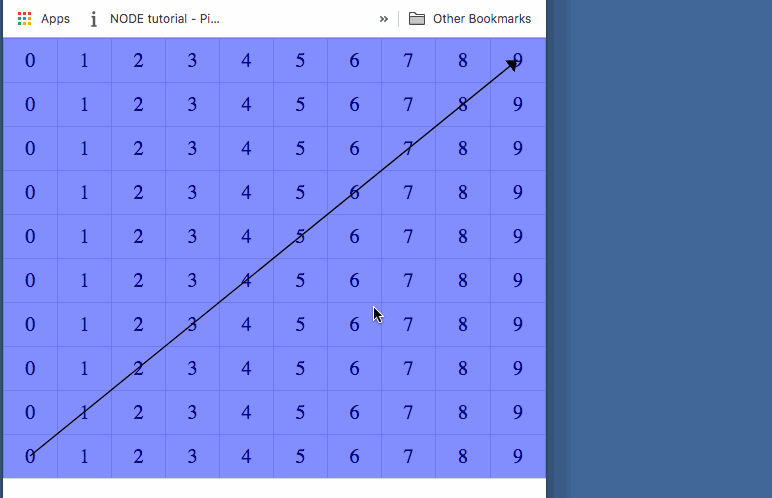È possibile utilizzare un elemento SVG e gli stili CSS per la posizione assoluta sovrapposta alla tabella. E ottieni il punto di inizio e di fine dall'API DOM JavaScript comegetBoundingClientRect()
Ecco una demo. (Realizzato con Angular, ma puoi usarlo ovunque. Esempio di puro JavaScript vedi sotto.)
const startElement = document.querySelector('#start');
const endElement = document.querySelector('#end');
const startRect = startElement.getBoundingClientRect();
const endRect = endElement.getBoundingClientRect();
const startX = startRect.right;
const startY = startRect.top;
const endX = endRect.left;
const endY = endRect.bottom;
È possibile modificare l'inizio e la fine in modo dinamico. Devi solo reinvocare il metodo per ottenere le posizioni. Nota che uso il pulsante sinistro, superiore, destro per posizionare la freccia sul bordo dell'elemento. È possibile calcolare il punto centrale o il bordo confrontando entrambe le posizioni.
E devi posizionare lo svg sul tavolo. Puoi farlo impostando css position: absolute; left: 0; top: 0. Ma nota che anche il tuo genitore dovrebbe avere l' positionattributo. per esempioposition: relative .
Aggiornamento: qui una demo JavaScript pura. Fare clic a sinistra per visualizzare tutti i file e selezionare index.js per visualizzare i contenuti JS. (come nel codice VS).
Codice completo:
<table style="position: absolute; left: 0; top: 0;">
<tr>
<td>0</td>
<td>1</td>
<td>2</td>
<td>3</td>
<td>4</td>
<td>5</td>
<td>6</td>
<td>7</td>
<td>8</td>
<td id="end">9</td>
</tr>
<tr>
<td>0</td>
<td>1</td>
<td>2</td>
<td>3</td>
<td>4</td>
<td>5</td>
<td>6</td>
<td>7</td>
<td>8</td>
<td>9</td>
</tr>
<tr>
<td>0</td>
<td>1</td>
<td>2</td>
<td>3</td>
<td>4</td>
<td>5</td>
<td>6</td>
<td>7</td>
<td>8</td>
<td>9</td>
</tr>
<tr>
<td>0</td>
<td>1</td>
<td>2</td>
<td>3</td>
<td>4</td>
<td>5</td>
<td>6</td>
<td>7</td>
<td>8</td>
<td>9</td>
</tr>
<tr>
<td>0</td>
<td>1</td>
<td>2</td>
<td>3</td>
<td>4</td>
<td>5</td>
<td>6</td>
<td>7</td>
<td>8</td>
<td>9</td>
</tr>
<tr>
<td>0</td>
<td>1</td>
<td>2</td>
<td>3</td>
<td>4</td>
<td>5</td>
<td>6</td>
<td>7</td>
<td>8</td>
<td>9</td>
</tr>
<tr>
<td>0</td>
<td>1</td>
<td>2</td>
<td>3</td>
<td>4</td>
<td>5</td>
<td>6</td>
<td>7</td>
<td>8</td>
<td>9</td>
</tr>
<tr>
<td>0</td>
<td>1</td>
<td>2</td>
<td>3</td>
<td>4</td>
<td>5</td>
<td>6</td>
<td>7</td>
<td>8</td>
<td>9</td>
</tr>
<tr>
<td>0</td>
<td>1</td>
<td>2</td>
<td>3</td>
<td>4</td>
<td>5</td>
<td>6</td>
<td>7</td>
<td>8</td>
<td>9</td>
</tr>
<tr>
<td id="start">0</td>
<td>1</td>
<td>2</td>
<td>3</td>
<td>4</td>
<td>5</td>
<td>6</td>
<td>7</td>
<td>8</td>
<td>9</td>
</tr>
<svg style="position: absolute; left: 0; top: 0; width: 100%; height: 100%; z-index: 1">
<defs>
<marker id="arrow" markerWidth="10" markerHeight="10" refX="5" refY="3" orient="auto"
markerUnits="strokeWidth" viewBox="0 0 20 20">
<path d="M0,0 L0,6 L9,3 z" fill="#f00" />
</marker>
</defs>
<line id="svg-line" stroke="#f00" stroke-width="5"
marker-end="url(#arrow)" />
</svg>
</table>
<script>
const svgLine = document.querySelector('#svg-line');
const startElement = document.querySelector("#start");
const endElement = document.querySelector("#end");
const startRect = startElement.getBoundingClientRect();
const endRect = endElement.getBoundingClientRect();
const startX = startRect.right;
const startY = startRect.top;
const endX = endRect.left;
const endY = endRect.bottom;
svgLine.setAttribute('x1', startX);
svgLine.setAttribute('y1', startY);
svgLine.setAttribute('x2', endX);
svgLine.setAttribute('y2', endY);
</script>
Basta copiare il codice sopra in un nuovo file html vuoto ed eseguirlo nel browser.
Btw. Puoi anche farlo con una tela. (alternativa a svg)

